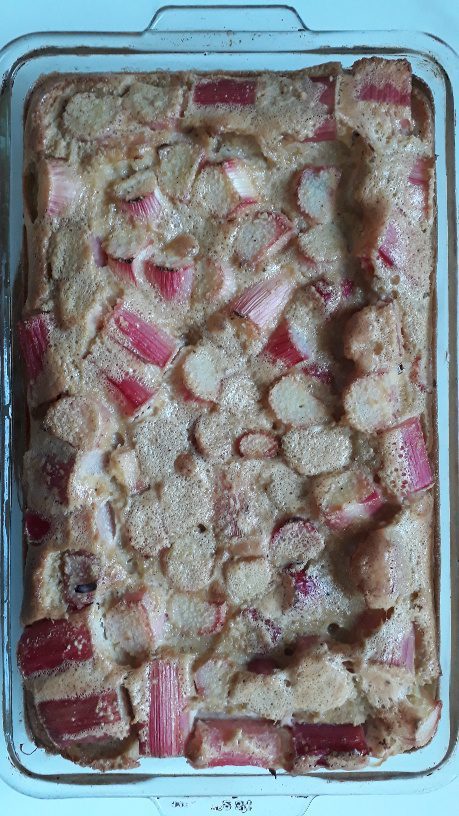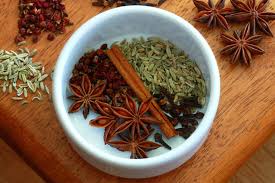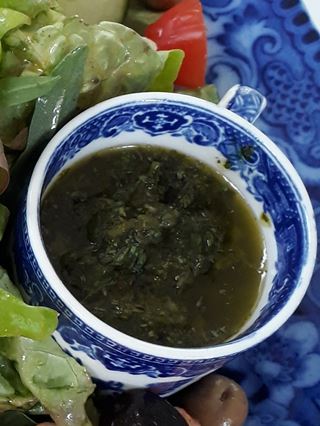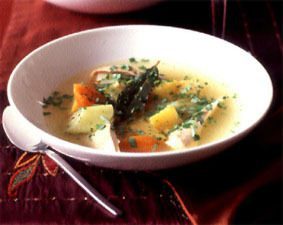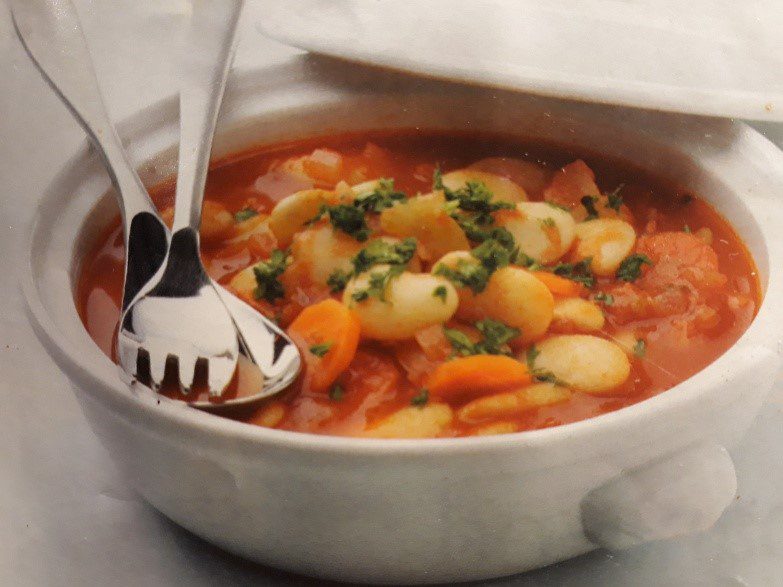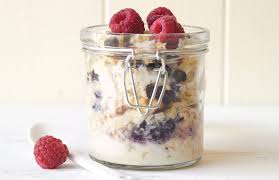
Apr 4, 2020 | Anna's Best Recipes, Desserts & drinks
I have adapted this from the recipe by littlejarofspices. Had it last week and it was GORGEOUS. The original recipe uses an additional 2 tbs of coconut sugar which after the first 10 minutes of baking you sprinkle over the top of the clafoutis to give a caramelised top. I didn’t bother. A dollop of coconut-based yoghurt or whipped cream is lovely on the side. I personally used half gluten free flour (my own blend of sorghum, millet and oat flours) and half finely ground almonds but either works well.
Makes 8 servings
4 stalks (200g) of rhubarb
4 medium eggs
100g almond flour (finely ground almonds give a nice smooth texture, or use your own blend of gluten-free flour flour or glutinacious)
45g coconut sugar (for a lovely caramel flavour)
70g xylitol or erythritol (e.g. Dr Coy’s Stevia Erylite)
250 ml unsweetened almond milk, coconut milk or milk
1 tsp vanilla extract (vanilla “essence” contains gluten)
Coconut oil (or if you eat dairy, butter) for greasing
Pinch of pink salt or sea salt
1.Preheat oven to 190°C and grease a ceramic pie dish/pyrex dish with butter or coconut oil.
2.Wash the rhubarb stalks, chop off and discard the ends and cut them into 2.5 cm pieces and place them in the dish.
4. In a bowl, combine almond flour/gluten-free flour, coconut sugar, xylitol/erythritol and salt. Whisk in the eggs, milk and vanilla extract. The batter should be very thin & liquid.
5. Pour the batter over the rhubarb pieces in the pie dish and place in the oven on the middle rack. Bake for 25 minutes. If it still looks very very liquid in the centre, you might need to give it another 10 minutes until just set.
6. Let cool around 20 minutes before serving.
Why this is better for you:
This avoids a lot of the problems of conventional sugar which suppresses immunity and raises inflammation. Coconut sugar has a lower glycaemic index than sugar and still contains some nutrients. But do remember that coconut sugar is still a high carbohydrate (high natural sugar) ingredient. So this dessert isn’t a staple but more of a weekend or special treat.

Mar 27, 2020 | Anna's Best Recipes, Dressings, rubs, spreads, sauces & more
Did you know that shop-bought spice mixes often contain gluten which is not always listed on the packet? Anyway that’s only really relevant for you gluten-sensitive people out there.
Once you taste this beautiful five spice powder in your stir fries, sprinkled on salmon before grilling, or in a home made hotpot you will never want to go back to commercial, tasteless five spice. Do keep your spices in airtight glass jars somewhere dark. Left in the sun, they lose their marvelous antioxidant potency and their taste too. All spices have hundreds (and some thousand) of peer-reviewed clinical research papers showing various health benefits. When you cook food with spices the food generates fewer toxic by-products (e.g. from grilling, sauteeing or roasting) and the spices stimulate your body’s own antioxidant defences.
1 dsp (dessertspoon) ground Ceylon cinnamon
1 dsp ground cloves
1 dsp fennel seed, ground
1 dsp ground star anise
1 teaspoon Szechuan peppercorns, ground
Electric coffee grinder or spice grinder
1.Grind your fennel, star anise and peppercorns.
2.Mix the spices together and store in an airtight jar somewhere dark.

Feb 7, 2020 | Anna's Best Recipes, Dressings, rubs, spreads, sauces & more
Every herb has healing properties so herb pesto isn’t just about making your food taste even better. Herbs stimulate your body to make more antioxidants. But herbs also have a selective antibiotic effect. That is, every herb has action against certain disease-causing bacteria* AND encourages growth of friendly bacteria in your gut. Different herbs discourage different “bad” bugs.
For the most powerful health effects place the pesto in a clean glass/ceramic jar and leave to ferment on the kitchen counter for 2 days before using. The fermentation potentiates the polyphenols (beneficial plant compounds) making them more usable by your body. Using the garlic helps keep the pesto fresher but isn’t essential. If any fluffiness develops on the top of you pesto just scrape it off before using.
The proportions of ingredients to each other don’t really matter so long as you end up with something that’s not too runny.
A generous handful of one fresh herb: Thyme, oregano, parsley, mint, sage, coriander, basil, tarragon, dill are all good. Rosemary is fantastic as well but very strong-tasting – maybe do 1/2 and 1/2 with parsley.
Extra virgin olive oil to bind (1/2-1 cup)
Optional: 2 large cloves freshly crushed garlic
- Wash the herbs, remove any woody stems (for soft herbs like dill, parsley and basil you use the whole stem so long as its soft).
- If using a mini food processor cut the herbs roughly into 2cm lengths then blitz with the garlic and 1/2 cup of the olive oil until you get a paste. If the food processor isn’t catching the herbs you can add more oil to make it all go round.
If making the pesto by hand chop the herbs finely (a mezzaluna or a large knife with a smooth curved blade is good for this). In a bowl mix with the garlic and extra virgin olive oil. - Decant into a clean glass or ceramic jar covered with a saucer, a piece of muslin, or the lid laid loosely on top. Leave at room temperature for 48 hours before starting to eat. It will be fine for a week in the fridge.
Tip: if the pesto starts to go very brown (this happens with basil and coriander) add a thin layer of extra virgin olive oil on top to help preserve the colour.
Good to know:
Did you know that many gut bacteria are normal in certain amounts but toxic if they overgrow. For example the yeast-like fungus known as candida. Small amounts in your gut are normal but when you have a high carbohydrate diet or take antibiotics or acid-blocking drugs candida can take over. It develops a filamentous form (hyphae) which invade your gut lining and cause damage. Food sensitivities, digestive symptoms, autoimmune conditions (e.g. hypothyroidism) and even mood changes can result.

Feb 7, 2020 | Anna's Best Recipes, Main courses
I adapted this from a recipe by Raymond Blanc to include more greens and a little less stodge. It makes a lovely, gently flavoured dinner. Even my husband, who says he doesn’t really like meals that involve broth, likes this one.
In my newsletter last month (to people who subscribe for FREE via my website www.annacollins.ie), I talked about why chicken broth can help prevent wrinkles. To make this even more nutritious you could make the following meal using home-made chicken stock (made by boiling organic chicken bones in water and a dash of apple cider vinegar) instead of the water in the recipe. Or use chicken pieces on the bone instead of fillets. I like to make a four-person amount and reheat thoroughly for another dinner later in the week
For 4
3 large carrots, peeled and sliced into bite-sized chunks (about 2cm thick)
1 small (Swede) turnip, peeled, cut into bite-sized cubes
4 small organic chicken legs, 2 breasts on the bone cut in two, or failing that, 4 fillets (but chicken with bones is better)*
6-8cm piece of fresh root ginger, peeled and thinly sliced
4 garlic cloves, peeled and sliced
2 large heads broccoli, cut into florets
Optional extras: (NOT for SC diet): 100g 100% buckwheat noodles/rice noodles (soak in boiling water 5 mins, drain and refresh in cold water until ready to use at the end).
Tamari sauce (this is a gluten-free soya sauce)
1. In a large saucepan cover the turnips and carrots with boiling water and boil for 10 mins.
2. Add the whole chicken fillets, garlic, ginger, making sure all just covered with water and cook (simmer) for 15 minutes.
3. Add the broccoli and cook for a further 5 minutes.
4. Check that the chicken is cooked. When it is done
5. Divide the cold cooked noodles between 4 large bowls. Cut up the chicken fillets into bite-sized slices if you can be bothered.
6. Ladle in the rest of the ingredients on top of the noodles and chicken
7. Provided you are NOT on the SC diet you can add tamari sauce to taste. For SC diet just add more salt and pepper.
Variation (not for SC diet!):
For a mostly vegetarian version, add 100g cubed fermented tofu or tempeh, cut into bite-sized cubes at the same time as the broccoli, and use chicken stock or a chicken stock cube (provided you are not a purist vegetarian!)
Why this is good for you
Swede turnips, carrots and all orange fruits and vegetables are a rich source of carotenoids such as beta carotene. Eating a diet rich in beta carotene and other carotenoids found in green, red and purple vegetables will give your skin an attractive golden glow, according to a study of university student who increased their fruit and veg intake for a few weeks. Beta carotene is also important for clear skin, excellent eyesight and helping prevent wrinkles and digestive problems. The list of its activities is endless so I won’t bamboozle you with more details! Broccoli is a great source of folic acid, which helps daily repair and maintenance of your stomach and intestines. It’s also rich in indole-3-carbinol, which helps your liver get rid of the hormone-disrupting chemicals that can cause low thyroid, hair loss and dry skin.
Did you know that organic/free range chicken bones, boiled, yield a powerhouse of immune supporting nutrients like proline and collagen, which help heal your gut? Naturally reared chicken (organic) is better because intensively farmed chickens have high levels of toxins (heavy metals) inside their bones. These toxins are released when you boil the bones for a long time to make soup. Gut healing is important on a day to day basis because every 72 hours you shed your single-cell thick gut lining. Without lots of repair going on constantly, your ability to keep that gut lining working properly declines. Result: poor nutrient absorption, increased tendency to food sensitivities and autoimmune symptoms(e.g. hypothyroidism). You also increase your risk of sepsis (a life threatening condition that can occur with viral and other infections). So really, keeping your gut in tip top shape is one of the most important keys to great health.

Jan 6, 2020 | Anna's Best Recipes, Desserts & drinks
Do you love warm, spicy drinks? I do and love the idea of chai but dont really like the sugar laden, condensed-milk builders tea type on offer in Indian restaurants. Traditionally chai is made from tea, spices, sugar and condensed milk. No exactly a vitality-boosting beverage. I swapped the tea for naturally caffeine-free rooibosch tea which (unlike traditional tea) doesn’t blocknutrient absorption. I sweeten it without sugar and use a non-dairy milk instead. This tea aids detoxification due to the spices – quite a nice thing to do at this time of year if, like me, you ate (and drank) a bit more than was good for you during the holidays.
I’ve included a simple chai recipe you can make on the spot, and also a chai blend you can mix up and keep in an airtight container somewhere dark. Always keep your dried spices in a dark place in an airtight container to avoid loss of potency.
If you like your tea black, substitute water for the milk. I fyou like it made entirely on milk, feel free to do that but bear in mind almond milk can split when you boil it for a long time so coconut (or dairy) milk will give you a better consistency at the end.
Basic Chai
To serve 2:
1 1/2 cups (about 350ml) water
1/2 cup milk of your choice – cow, unsweetened almond/coconut
2 rooibosch teabags or 3 heaped teaspoons loose rooibosch tea
6 cracked cardamom pods
½ cinnamon stick, crumbled
grating of fresh nutmeg
4 cloves
Optional sweeteners: stevia drops (or xylitol/erythritol)
Put the spices, water and tea into a saucepan, bring up to the boil, turn down and simmer, covered with a lid, for 1-15 minutes. Add milk and sweetening to taste.
Posh Chai Blend to use again and again
I adapted this from a lovely Fortnum and Mason blend my nephew gave me. But using South African Redbush (rooibosch) instead of normal tea enhances the health benefits.
6 heaped dessertspoons loose rooibosch tea
3 cinnamon sticks, broken up with your hands (make sure it’s the real Ceylon cinnamon, which looks like rolled cigars. The cinnamon that looks like rough bark is only Cassia cinnamon, which doesn’t have the health benefits)
20 cloves
1 heaped teaspoon cracked coriander
20 cracked cardamom pods (bash whole coriander seeds and cardamom pods in a pestle and mortar for a minute)
1 level teaspoon ground ginger
2 star anise if you have them, broken up
1 teaspoon whole fennel seeds
To serve 1:
3/4 cup 9about 180ml) water
1/4 cup unsweetened coconut or almond milk
1 dessertspoon posh chai blend
Stevia drops (or xylitol/erythritol) to taste
Why this is good for you:
I love to make meals and drinks that contain spices. Did you know that spices stimulate your body to make more antioxidants? The spices themselves also help reduce numbers of disease-causing bacteria and increase numbers of friendly ones. This is very relevant if you would like to maintain fantastic vitality and health as you go through life. Spices help protect you from almost all chronic diseases. The more different types you take in, the better.
Tannins in tea bond to nutrients in your meals and prevent you absorbing these precious nutrients. Tea is also naturally high in aluminium, which is a toxic metal. Green tea is interesting because if you make it the traditional way you reduce the tannins a lot and aluminium significantly. Green tea also contains epigallin catechate, a powerful protector against cancers, premature ageing and much more. That’s why its OK to drink a couple of cups of green tea a day if you make it the traditional way. To make green tea the traditional way pour boiling water on leaves, infuse 1 minute, throw away water then use fresh boiling water to brew the tea for 5 minutes.

Jul 15, 2019 | Anna's Best Recipes, Dressings, rubs, spreads, sauces & more
I have to say this is the most delicious mayo recipe I have ever tasted. I so enjoyed it with steamed asparagus and a couple of boiled eggs for lunch today. Personally I like using a half and half mix of extra virgin sunflower/sesame and olive oils. Extra virgin sesame oil has a neutral flavour similar to sunflower, in my opinion. Nothing like the usual sesame oil, which is super heat-treated. Dijon mustard, salt and herbs preserve the mayo longer. When its gone over, you’ll know because it will have separated or gone runny. One yolk will bind up to 1 litre of oil so for a bigger batch you only need to increase the other ingredients.
1 medium/large organic egg yolk, at room temperature
1 tbs Dijon mustard, at room temperature
230ml extra virgin (cold-pressed) oil: olive, rape, sunflower or avocado
1 dsp apple cider vinegar or lemon juice
Himalayan salt
Pepper
Optional: 2 tablespoons herbs to add at the very end: e.g. fresh chopped tarragon,parsley, coriander or chives.
- Bring the egg and mustard to room temperature in advance (chilled eggs/Dijon will leave you with a runny, disappointing sauce!).
- Mix the egg and mustard with a stick blender or whisk and while whisking add the oil slowly in a thin stream (this is essential). The mayo should start to thicken. Many food processors now have a cap on top that has a small hole for this purpose.
- Continue whisking and adding until the oil is used up and the mayo is set.
- Add vinegar/lemon juice. Mix some more and season with salt and pepper and whatever herbs you are using.
- Let the mayonnaise rest in the fridge before serving – this allows the flavour to develop and the mayonnaise to thicken further.
Why this is better for you:
As you’ll know if you’ve been a client of mine, omega 6 oils in the form most people eat them, are toxic. Omega 6 oils like sunflower, rape, safflower, sesame, canola, soya and “vegetable oil” are heat treated to give them a long shelf life. This makes their chemical structure change to one that interferes with metabolic functions as they are incorporated into our cell membranes in EVERY tissue of our body. They are used as cooking oils, and to make bread, cakes, biscuits and confectionary and of course in ready meals, to give them a nice mouth feel.
So if you’d like to avoid or reduce chronic health conditions, swapping out your heat-treated nut and seed oils for healthier options is a winner. For food prep use either extra virgin olive oil or (never cooked) extra virgin nut/seed oils like sesame, sunflower, rape, walnut and hazelnut. Commercial mayonnaise is ALWAYS MADE WITH REFINED OILS (if you find one that’s not, do let me know so I can tell everyone!). Bottom line, we are all deficient in these life-giving untreated, never heated, omega 6 oils. DID YOU KNOW that mustard can be a powerful tool against eczema (dermatitis)? A study a few years ago showed that eating mustard daily prevented eczema in mice. Who knew??

Apr 23, 2019 | Anna's Best Recipes, Main courses
This recipe is super-easy. It’s what I make when I come home late and want dinner on the table in 15-20 minutes.
For 2
2 salmon darnes/fillets/steaks, ideally wild or organic
A large clove of garlic, peeled and crushed
Tamari Sauce (see “larder & shopping” for where to buy)
1. Brush fish on both sides with the sauce, smear with the garlic.
2. Grill on medium heat for around 5 minutes flesh side up and 1-2 minutes skin side up until very slightly browned (watch it when grilling the skin side, it goes from not done to burnt very quickly).
Serve with:
- Steamed green or runner beans drizzled with fresh lemon juice or a large salad of mixed leaves, cherry tomatoes and sliced red onion drizzled with my home-made mediterranean or Asian salad dressing or a little fresh lemon juice and a glug of extra virgin olive oil. These accompaniments are suitable for a paleo (stoneage) or ketogenic eating diet.
- If you don’t want to lose any weight you could also add a medium steamed or baked sweet potato (just scrub, slice and steam with the skin on for extra nutrients) or some baby boiled white potatoes. Carbohydrates (grains, potatoes, sweet foods) are weight gainers.
Why this recipe is good for you:
Oily fish is a great source of omega 3 essential fats needed for weight management, beautiful skin and good brain function. Eating fresh rather than tinned fish is best because the plastic lining of tins contains bisphenol A (BPA). Fats in the food absorb BPA. BPA is linked by numerous studies to sex hormone imbalance (eg PMS, low libido, endometriosis, fibroids) and life-threatening diseases of the breast and prostate. Greens are a rich source of magnesium, which helps the liver clear natural and man made toxins from the body. common symptoms of magnesium deficiency include stress, wheezing in asthmatics, and sluggish bowels.

Apr 15, 2019 | Anna's Best Recipes, Main courses, Packed lunches
I love to eat a variation of this vitality-boosting salad for lunch most days. For a packed lunch put all the veggies including the garlic in a large lunchbox, store the dressing in a glass jar separately and put the fish or other topping in a glass or non-toxic container until ready to eat. The great thing about this is that because it doesn’t overload you with carbs (bread, grains, potatoes etc) you don’t tend to get that after-lunch sleepiness. For a change from tuna try a couple of boiled eggs, a cup of cooked butterbeans or beans (mixed with pesto and garlic) or a serving (80-100g) of smoked salmon or leftover roast chicken. Keep it interesting by changing around the types of leaves and the topping.
For 1:
Topping:
80-100g (half a large tin) tuna in spring water (or brine if you can’t get in water)
Salad:
1/2 a red/yellow pepper, de-seeded and sliced or cut in chunks
1 large vine tomato (cut in wedged) or 8 cherry tomatoes (halved)
1/4 red onion, sliced thinly
1/4 small cucumber or half a small courgette, sliced
A few black or green olives
2 large handfuls leaves (choose from baby spinach, lettuce, rocket, chicory, endive, watercress, landcress, pursalane, baby chard, flat leaved parsley leaves)
2 dessertspoons of home made extra virgin olive oil based dressing (see recipe on this blog)
1 small clove of garlic, crushed
Optional: half a cup of freshly grated raw beetroot or carrot
Optional: half a ripe avocado, cubed
1. In a large bowl mix all the salad ingredients with the dressing until everything is coated and glossy.
2. Pour out onto a plate, top with the tuna and enjoy.
Why this is great for you:
Did you know that eating lots of different plant foods every day is one of the most important things you can do for yourself. My guideline to patients is to try for 25 different plant foods (fruit, veg and beans/pulses) in the week. Each plant colour and type contains a different range of nutrients. Purple fruit and veg for example, contain proanthocyanadins, while orange and red plant foods contain carotenoids and green ones contain lots of magnesium. These are just some of the nutrients that help give you flawless (and young-looking) skin and hair, help repair and maintain your digestive system and keep you free of inflammatory conditions like eczema, asthma and digestive disorders like gastritis and colitis. Different plant foods feed different good bacteria to help you stay at your peak fitness and wellbeing. So its not just about eating large quantities of veg (half your plate at lunch and dinner) but large variety too. How many colours of fruit and vegetables can YOU eat today?

Feb 28, 2019 | Anna's Best Recipes, Main courses
Because I am an indolent cook and destalking thyme is a pain I leave the thyme leaves attached to the sprigs. They usually fall off in the cooking and then you only need to fish out the denuded twigs. I don’t do this with rosemary – the leathery leaves go everywhere and the texture isn’t good – so I chop the rosemary finely.
1 tbs extra virgin olive oil
1 red onion, chopped
2 cloves garlic, crushed or finely chopped
1 mugful of bite size chunks of root veg: choose from Swede or white turnip, Jerusalem artichokes or (for people NOT on SC diet) potato or sweet potato.
1 large carrot, sliced
1 large stick celery, sliced
1 tsp each ground cumin and coriander
½-1 tsp cayenne pepper
400g can butter beans (drained) or soak (overnight) 200g dried butter beans in water and boil til tender.
250 g tomatoes, chopped (fresh or tinned)
Large handful fresh thyme sprigs
6” sprig fresh rosemary, destalked and finely chopped (or you can leave the whole sprig in and then spend ages picking the annoying leathery leaves out when everything’s cooked)
150ml vegetable stock (For SC diet add 1/2 teaspoon additive free Vegetable bouillon powder such as Dr Coy’s to boiling water). If you don’t need SC diet-friendly use Vecon vegetable bouillon powder or Kallo vegetable stock cube.
5 juniper berries, lightly crushed
3 tbs fresh parsley, finely chopped (you can chop and keep in the freezer for easy use)
- Add the oil, onion, garlic, potato/Jerusalem artichoke/turnip, carrot, celery and spices to a heavy bottomed saucepan or casserole, give everything a stir to mix with the oil and spices, put on the lid, and sweat for 5-10 mins until the onion is translucent but not brown. You might need to add a splash of water to stop everything browning.
- Add the cooked beans, tomatoes, thyme sprigs, rosemary, stock, juniper berries, bring to the boil, cover with a lid and gently simmer till the vegetables are cooked.
- Garnish with parsley.
Serve with:
Steamed broccoli or a green salad dressed with a little olive oil and lemon juice
Optional extras (for people NOT on SC Diet) choose one:
Quinoa grains – 11% protein so great with a beany dinner. Its protein keeps added to the bean protein keeps you fuller for longer. Cook in twice its volume of boiling water in a covered saucepan – around 8-10 mins until it looks bobbley.
Brown rice (add a little turmeric to the water before cooking for a lovely golden colour)
Why this is good for you:
Beans are a rich source of magnesium which you need for calm, sleep, clear skin, proper muscle and liver function and much much more. Stress, refined foods (sugar/white grains), alcohol, stimulants and smoking rob magnesium from your body. Millet is also rich in magnesium.
Fresh thyme, rosemary and spices are rich sources of phytochemicals (also called polyphenols or bioflavonoids). These are natural antioxidants many times more powerful than vitamins and minerals. Phytochemicals help reduce inflammation. This helps prevent or relieve conditions like heart disease and any condition with an -itis – arthritis, dermatitis, bursitis etc. It doesn’t help with work-itis, which I used to have in my old job!

Feb 22, 2019 | Anna's Best Recipes, Breakfasts & smoothies
I like to soak my muesli the night before because it makes grains, nuts and seeds super digestible and more filling. Unsoaked grains contain phytates which impede your mineral absorption. Making your own muesli is great because you can use the nuts and seeds you prefer. Commercial muesli is often high in dried fruit, which just gives you too much carbohydrate (sugars) at one sitting. It can also load up on cheaper ingredients like wheat flakes, instead of better-for-you oats. I love to add a heaped teaspoon of ground ginger and 2 of Ceylon cinnamon when making the muesli because I love the antioxidant punch of spices which keep you healthier and younger looking for longer.
When I have early clinic I often make Birchner muesli. I put half a mug of muesli in a wide glass screw top jar, grate an organic apple in, add lots of kefir/yoghurt and mix it up, sometimes with a few drops of stevia if I am feeling like something sweeter or am using sour berries. Instant brekkie the following morning. Yum…
Luxury Muesli
3 cups gluten-free (or normal, if you tolerate gluten-contamination) jumbo oatflakes or porridge oatflakes
½ cup walnuts, broken into quarters, halves or roughly chopped
½ almonds, coarsely chopped
½ cup sunflower seeds
½ cup hazelnuts or Brazil nuts, coarsely chopped
½ cup organic whole chia seeds or linseeds (also known as flaxseeds)
½ cup chopped unsulphured apricots
½ cup dessicated coconut or large coconut flakes
Mix ingredients together and store in an airtight jar.
Serve ½ mug of this muesli with natural yoghurt, milk of your choice and a cupful of chopped fruit – apple, pear or berries.
If you need more sweetness, use a few stevia drops from health stores. Its a plant extract that’s much sweeter than sugar but without calories and negative health effects.
Birchner Muesli
Soak ½ a mug of this muesli in a bit more than double its volume of home made kefir or yoghurt overnight (for dairy free use almond or coconut based yoghurt – if it’s very thick you might need to add some non-dairy milk).
Serve with a grated organic apple/pear or 1 cup mixed fresh or frozen berries
As a yoghurt/kefir substitute you could use half water half cloudy apple juice to soak. This isn’t as good because it contains no protein and raises the (natural) sugars in the meal. But if you cant bear milk, yoghurt or kefir of any type with muesli (like my husband) what the hell…
A note about dairy sensitivities:
If you are mildly dairy-sensitive (you get symptoms but don’t have any major autoimmune health condition) you might like to try home made kefir. Kefir is a fermented milk product where the bacterial cultures have digested both the lactose (milk sugar) and casein (milk protein). I find that with any other dairy product, I immediately get a stuffed nose and throat, but not with home made kefir. You might be the same. Yay!! fully fermented home made kefir has over 20 varieties of beneficial bacteria to help your health. Even when good bacteria are killed by your strong stomach acid they still have a huge metabolic effect on you. How amazing is that…
